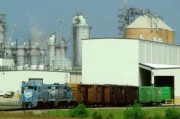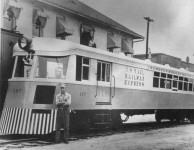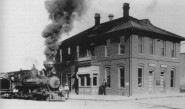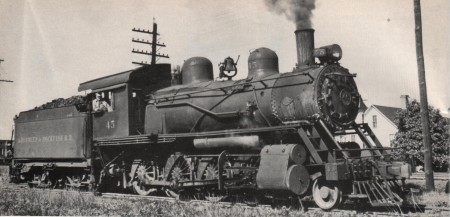In 1987 the A&R got a new president well-known in short line railroading, and the line set about growing through the acquisition of nearby CSX branches. Ed Lewis, whose resume includes the nation's oldest short line and biggest tourist carrier, the Strasburg Railroad, and Vermont's legendary Lamoille Valley railroad as well as the Twin States Railroad, came to the A&R in January 1987. Lewis, best known among rail enthusiasts as author of Kalmbach's American Shortline Railway Guide, didn't take much time to make an impact on the Carolinas short line world.
In October 1987, the A&R became the parent road for the Pee Dee River Railway Corp., a 15-mile line between McColl and Marlboro just across the border in South Carolina. Marlboro County purchased the line following CSX abandonment and leased the operation to the A&R's Pee Dee River Railway s ubsidiary. Initially A&R GP-7 #205 went South to operate the new line, but a rebuilt CF7 painted in a simplified version of the A&R's turquoise and orange paint scheme has made its home in Bennettsville. Traffic on the Pee Dee line included pulpwood, fertilizer and other goods but has much expanded in the last two years following the opening of a $350,000,000 paper mill. The line now operates seven days a week serving the Domtar paper mill, two Flakeboard mills, Mohawk Carpet, Hanson Aggregates and Southern States.
ubsidiary. Initially A&R GP-7 #205 went South to operate the new line, but a rebuilt CF7 painted in a simplified version of the A&R's turquoise and orange paint scheme has made its home in Bennettsville. Traffic on the Pee Dee line included pulpwood, fertilizer and other goods but has much expanded in the last two years following the opening of a $350,000,000 paper mill. The line now operates seven days a week serving the Domtar paper mill, two Flakeboard mills, Mohawk Carpet, Hanson Aggregates and Southern States.
In the last month of 1987, the A&R purchased the 5.6 mile long Dunn-Erwin Railroad, the southernmost stem of the former Durham & Southern Railway, which joined CSX predecessor Seaboard Coast line in 1976. Although, the line north of Erwin was abandoned, the short segment was still a vital connection for a denim plant in Erwin. An SW1200, assigned for a time to the Pee Dee River then transferred to the Dunn-Erwin line, picks up cars off the CSX interchange track in Dunn. Following the closing of Erwin Mills, the line was abandoned. At the conclusion of 2007, Ed Lewis and Paul McArdle retired. Succeeding them are Garland Horton and Paul Barnes, respectively.
Regular A&R service involves a switching operation in Fayetteville, which shifts cars to and from the many industries there from the Norfolk Southern and CSX Transportation interchanges. The Fayetteville-based switcher keeps busy serving a number of local industries, including resin manufacturer Hexion Chemicals, and River Terminal.
The A&R is one short line that has been conscious of its history. In Raeford, the A&R depot became the local Chamber of Commerce office. In Aberdeen, one of the A&R’s famous side-door cabooses rests beside the old Union Station (now a museum) and another is located beside the railroad’s general office. In 1992 the company celebrated its 100th anniversary with a party for owners, employees and shippers featuring a cookout, music and train rides using one of the old cabooses.
Such thoughtfulness is the stuff good short lines are made of, especially one that calls itself “The Road of Personal Service.” It’s the kind of railroad about which Lucius Beebe might wax poetic today – and the kind John Blue would be proud to see reach and pass its 100th year.
OPERATING THE A&R
The postwar A&R was aggressive. One of the first southern short lines to dieselize, in 1947 the A&R bought its first internal combustion locomotive from EMD, and F3 numbered 200. The line followed up with F3 201 the following year. During its early history, the A&R had a varied collection of motive power that included a 2-4-0, 4-4-0s and 4-6-0s. Three light 2-8-2s and a 2-8-0 were the mainstay in later years, but now the A&R was to be one of the few short lines to own cab units. Interestingly, the A&R's motive power history in the diesel era is preserved intact and in operation today with GP7 205, GP18 300 and GP38 400 rotating through the shop, on the road job and in use on the Fayetteville switcher.
Still, the old ways die slowly in the Carolinas. As late as 1977, the A&R still rostered one steam locomotive. Mikado No. 40 remained at the Aberdeen Shops for years, a sentimental favorite on the line and a curiosity that frequently traveled in tow to various A&R communities to participate in local festivals. The steamer was eventually destined to go on permanent display in Aberdeen, but in 1977 the locomotive and tender were loaded on two flatcars and shipped north to their new owner, the Valley Railroad of Essex, Connecticut where it continues in service today.
Except for special troop movements to Fort Bragg that continued through the 1960s, A&R passenger service died when the "jitney" was retired in 1950. The only public excursion operated since then took place one weekend in October 1981 when the Old North State Chapter NRHS used three of its cars on a pair of trips over the A&R.
In modern times, the A&R fielded a fleet of boxcars painted in a light blue paint scheme with orange lettering and a handful of other freight cars, including gondolas bearing the line's slogan: "The Road of Personal Service." And until the early 1980s, A&R freights still carried one of two unique, homemade cabooses, complete with side door for less than carload freight.
The late 1980s brought more than rust to the flanges of the cabooses in Aberdeen. Things were changing to make the A&R a player in the growing business of running multiple short lines.
A SHORT LINE EMPIRE
PEACE AND DIESELS
The A&R seems to have taken the Great Depression in stride. The line was among the first in the country to buy trucks to provide door-to-door service from the railhead to off-line businesses, doing so in 1931. Three years later, when the city of Fayetteville decided to build a cargo terminal on the Cape Fear River, the A&R fulfilled a 20-year dream of a rail-water connection and extended its main line about 1.5 miles to the river. Though the distance wasn't great, the A&R's action provided the city with the last requirement needed so revenue bonds could be issued to pay for the project. The terminal, of course, became yet another source of traffic for the A & R, initially bulk oil shipments brought off Atlantic shipping lanes, up the Cape Fear and delivered inland from the A&R
The A&R was no different from many of the nation's trunk railroads during World War II. Swamped with traffic, running around the clock to keep up with the demands for war materials, troop movements and civilian needs, the A&R put in a yeoman's performance. And it had to. During the war, the Fort Bragg base was expanded, and much of the materials for the new buildings and renovations traveled over the A&R. This level of activity necessitated the suspension of one of the longest-standing rules on the Blue Family's railroad: A strict Presbyterian clan, they did not believe in running the A&R on Sundays. For the war, things changed while as many as five steam locomotives at one time were in operation to keep up with the flood of 18 and 20-car troop trains rolling double headed across the Sandhills.
The war changed more than just the days the A&R ran. The sleepy Raeford depot, which had lost its place of importance with dwindling passenger traffic more than a generation before, got a facelift as a rest stop for weary servicemen riding the A&R.
Even “Time Magazine” recognized the importance of the A&R to the war effort. In its August 5, 1940, edition, Time declared: "Last week A&R had become a vital link in the U.S.'s national defense system. Over its contorted route moved tons of material to refurbish Fort Bragg...A&R's freight and passenger traffic to Fort Bragg was already up 15% over last year."
Some new 80-lb rail was installed, and a 100-car yard was built at Skibo in a $20,000 improvement project. This was big time for the A&R, which still had to take a ribbing from Fort Bragg officials used to a bigger and more direct rail line and said so. A&R official Henry Blue pointed out the strategic benefits of the A&R's snakelike route: "Hitler's bombers couldn't hit it twice on a bet." They never did, of course, and years later Henry Blue would put the little line's contribution in perspective by noting that more than 1 million soldiers rode over the A&R during World War II.
DEPRESSION AND WAR
Still, as is well recorded in the A&R's archives, some of the railroad's toughest times lay ahead. Federal control of the nation's railways through the united States Railway Administration during World War I was not kind to the A&R. Writing in the November 20, 1938, issue of the Raleigh, NC, News and Observer Newspaper, reporter C.G. Thompson summed up this period in the A&R's history: "While the larger trunk lines were tearing up their rails and installing new ones, buying up new rolling stock and engines to haul it and practically renewing all their physical properties at the government's expense, the A&R had to sit back with hurt pride and hope for crumbs that never fell
"The roadbed went bad, ties, rail and labor were scarce. Derailments caused delays and damaged cars that had to be repaired. Expenses piled up, customers scoffed at the service and became dissatisfied."
 For a time it appeared the line might be sold to other interests. There was talk that the Virginia & Carolina Southern might buy the line, and the Laurinburg & Southern, which had wanted to build through A&R territory earlier, came calling. After much negotiation, John Blue sold the Raeford-Wagram line to the Laurinburg & Southern in November 1921, a deal that provided badly needed cash to keep the A&R going. To trim costs, the A&R did away with its passenger service, substituting a rail motor bus known locally as the "jitney" to handle mail and carry passengers.
For a time it appeared the line might be sold to other interests. There was talk that the Virginia & Carolina Southern might buy the line, and the Laurinburg & Southern, which had wanted to build through A&R territory earlier, came calling. After much negotiation, John Blue sold the Raeford-Wagram line to the Laurinburg & Southern in November 1921, a deal that provided badly needed cash to keep the A&R going. To trim costs, the A&R did away with its passenger service, substituting a rail motor bus known locally as the "jitney" to handle mail and carry passengers.
Founder John Blue died in 1922, leaving to his children the task of rebuilding the A&R. Will Blue became president and chairman of the board of directors. One of his first major acts was to create a rail connection with the U.S. Army's Camp Bragg, which had been opened in 1918 as a field artillery training center. The military base took in some 200 square miles, including some of the old lands that had been logged in the years when the A&R was new. Even the area once occupied by the Endon branch became part of the military post. It was renamed Fort Bragg in 1922, and the Army had its own base railroad, the Cape Fear Railway, with which the A&R established a connection in 1926 just outside Fayetteville at Skibo (SKY-bo) Junction. This move, as we shall see later, proved to be extremely important for the A&R and the war effort during World War II.
HARD TIMES
I n 1912, with most of the trees cut down and the turpentine business waning, the A&R abandoned its Endon line and used the rails to build a branch from Raeford south to Wagram. At about the same time the ACL-backed Laurinburg & Southern Railroad Company, another short line to the south and east of the A&R, was building a rail line north toward Raeford and Fayetteville, one of the largest trading centers in the southeastern North Carolina. Had the A&R not built south to meet the L&S, it could have found itself stifled.
Seeing its halcyon days as a logger drawing to a close, the A&R began building its own line from Rockfish toward Fayetteville and an important junction with two ACL lines and the Norfolk Southern Railway's branch from Fuquay-Varina, near the state capital of Raleigh.
.The late 1912 arrival of the A&R in Fayetteville led to one of the most fascinating legends in A&R history. Although correspondence from the period suggests otherwise, it is told that giant Atlantic Coast Line didn't think too highly of the upstart A&R coming into Fayetteville and siphoning off traffic that could be turned over to arch-rival Seaboard Air Line at Aberdeen. The story goes that the A&R had planned to cross the ACL at grade just south of downtown Fayetteville, and the big carrier snubbed the shortlines's requests for a diamond. Undaunted, John Blue ordered his railroad built right up to the ACL's tracks on the west side and continued on the east side into Fayetteville. Then, late one night in December 1912, the A&R built itself a diamond. It seems the A&R loaded all of the ties, trac k laborers, their tools and some rails, took them to the site of the ACL crossing and put them to work before the ACL knew what was happening. Apparently the work went quickly, and somebody knew the ACL's schedules, for no trains derailed during this operation - if, in fact, it happened this way. Seeing itself defeated, the ACL apparently didn't complain, according to the legend, although papers show ACL corresponding favorably in the fall of 1912 concerning the need for an interlocking for the A&R crossing. Nevertheless, the story stands to this day, and the A&R still crosses ACL successor CSX where they say the midnight rail gang did its work. The first train, a passenger run on December 23, 1912, reached Fayetteville with John Blue on board.
k laborers, their tools and some rails, took them to the site of the ACL crossing and put them to work before the ACL knew what was happening. Apparently the work went quickly, and somebody knew the ACL's schedules, for no trains derailed during this operation - if, in fact, it happened this way. Seeing itself defeated, the ACL apparently didn't complain, according to the legend, although papers show ACL corresponding favorably in the fall of 1912 concerning the need for an interlocking for the A&R crossing. Nevertheless, the story stands to this day, and the A&R still crosses ACL successor CSX where they say the midnight rail gang did its work. The first train, a passenger run on December 23, 1912, reached Fayetteville with John Blue on board.
The arrival of the first A&R train captured the imagination of the people of Fayetteville. Here was John Blue, a Cumberland County country boy, back in his home county in command of an avenue of commerce; the Fayetteville business community was so impressed that in early 1913 it put on a special dinner honoring Blue. Said a commemorative booklet called Farmer Boy to Railroad President: "His career should be an inspiration to every boy who wants to make good in life, provided the boy is not afraid of the struggles and the hardships and the hard work that comes into the making of a strong character." Of course, there was a pitch to the readers of the booklet: "It would be so easy to route via SAL and A&R, and it would mean so much to this man who is one of you and who is doing so much to develop the country along his line, which in the long run means that he is helping Fayetteville."
With the completion of the Fayetteville line, the A&R line from Rockfish to Hope Mills was abandoned. The A&R now had an impressive list of connections, no less than five interchange partners. None of the on-line communities, save Aberdeen or Fayetteville, was of much industrial consequence at the time, but the country was a thriving agricultural area producing a bounty of crops. Cotton was the mainstay, but peaches and watermelons were important seasonal crops that found their way onto the rails of the A&R. By one estimation, there was a siding for agricultural loading an average of every 1 1/2 miles on the A&R.
Passenger service at this time was provided by a daily train leaving Aberdeen in the morning, arriving in Fayetteville at midday and returning in the evening. In addition, a mixed train originating in Fayetteville operated on a schedule opposite the passenger train. One round trip was made daily down the Wagram branch
EXPANSION AND REDIRECTION
It all started in 1892 with the construction of the railroad. But the origins of the line can be traced back almost another 100 years before that, to the arrival of the Blue family, immigrants from Scotland. Settling near the present-day location of the town of Aberdeen, they acquired Moore County NC farmlands and tracts of longleaf pine trees that grew as tall as 120 feet. Such timber stands were well suited to turpentine collecting operations and logging. Following the Civil War, the future of the turpentine business in south-central North Carolina was assured with the construction in the 1870s of the Raleigh & Augusta Air Line railroad (a predecessor of the Seaboard Air Line), which would bring better transportation to the region.
One of the first sidings on the A&R in the area was called "Blue's" and it soon became a loading area for naval stores, an important product for a state with dense pine forests. The name of the siding was later changed to “Blue's Crossing”, after Malcolm Blue, the largest landowner in the area.
In the late 1880's, Malcolm Blue's nephew, Civil War Veteran John Blue, moved from nearby Cumberland County to Blue's Crossing, which was renamed Aberdeen (after the Scottish seaport) in 1887. This was about ten years after the Raleigh & Augusta had completed its line from Raleigh to Hamlet, where a connection was made with the Carolina Central, an east-west line between the coastal port at Wilmington and the inland trading city of Charlotte.
In 1902, John Blue organized the Aberdeen & Rockfish Railroad Company. Chartered on June 22, it was authorized to run eastward from Aberdeen into the pine forests of the Sandhills region, a sandy area with hi gh ridges covering about 1100 square miles in five North Carolina counties. The line's route was projected to pass through the rolling hills into Blue's native Cumberland County. The terminus given on the charter was to be along "the Rockfish Creek." hence the name
gh ridges covering about 1100 square miles in five North Carolina counties. The line's route was projected to pass through the rolling hills into Blue's native Cumberland County. The terminus given on the charter was to be along "the Rockfish Creek." hence the name
Soon the 40-pound standard gauge rails of the A&R were threading their way into the Blue family's "turpentine orchards," and tiny 4-4-0 locomotives were bringing back cargo that had once trundled through the woods on wagons. Short branch lines were extended to several areas to reach the timber, and by 1895 the line had reached “Endon”, an aptly named mill community said to have had only three permanent residents and located at the end of the line near the headwaters of the Rockfish Creek.
Still, it wasn't enough for John Blue, who pushed the A&R further east through rural North Carolina communities: Raeford in 1898 (later the county seat of Hoke County after it divided from Cumberland County), Dundarrach in 1901, the community called Rockfish in 1902, Fenix in 1904 and Hope Mills in 1905. It is interesting to note that until 1891, when lumber mills were constructed at Hope Mills, this community was also known as Rockfish
Could it have been that this and not Rockfish Creek was the namesake terminus John Blue had in mind when he named the railroad? We may never know, for there are no records that speak to the matter, but it is possible. What we do know is that construction of the A&R to Hope Mills provided an eastern gateway with the Atlantic Coast Line Railroad's north-south main line and the potential to carry traffic from the mill at Hope Mills back to the Seaboard Air Line.
Indeed, the A&R's remote location kept it little remarked, but the modern A&R still has appeal: its headquarters, a two-story Federalist-style building in namesake Aberdeen, is one of the most impressive structures in town. The A&R keeps its diesels maintained for the short but tough 2.5% Bethesda Hill grade out of Aberdeen. The line's quaint steam-era shops are located down the street from the sweet magnolia blooms and breathtaking mansions of Aberdeen where some of the homes belong to members of the Blue family, the A&R's only owner in the century of existence. In short, the Aberdeen & Rockfish is the kind of short line dreams are made of - with a hard-reality ability to survive and prosper.
ONE HUNDRED YEARS AGO
 The allure of the A&R that fascinated Beebe almost 50 years ago included decorative eagles on locomotive smoke box doors, the A&R's first-place ranking in the alphabetized Official Railway Guide and its homespun “jitney” passenger service. That A&R spunk was apparent to Beebe, who wrote of the A&R's "charm of the improbable which derives from a highly solvent and briskly functioning railroad far off the beaten track of conventional commerce and travel.
The allure of the A&R that fascinated Beebe almost 50 years ago included decorative eagles on locomotive smoke box doors, the A&R's first-place ranking in the alphabetized Official Railway Guide and its homespun “jitney” passenger service. That A&R spunk was apparent to Beebe, who wrote of the A&R's "charm of the improbable which derives from a highly solvent and briskly functioning railroad far off the beaten track of conventional commerce and travel.
In the south central part of North Carolina, the Aberdeen & Rockfish railroad has done something remarkable for over 100 years: Its trains have been fighting an uphill battle with the undulating profiles of the Sandhills country and winning freight traffic and profitability in the process. That alone is just cause for a Centennial Celebration for a 45-mile line that started as a logging road in the late 1800s, then recast itself into a mini-bridge route carrier and today serves as the healthy parent of a second profitable shortline. But what makes the A&R even more noteworthy is the kind of endearing features which inspired legendary rail author Lucius Beebe to devote five pages to the A&R in his classic 1947 short line tribute “Mixed Train Daily”.

|
© Copyright 2010. All Rights Reserved |

